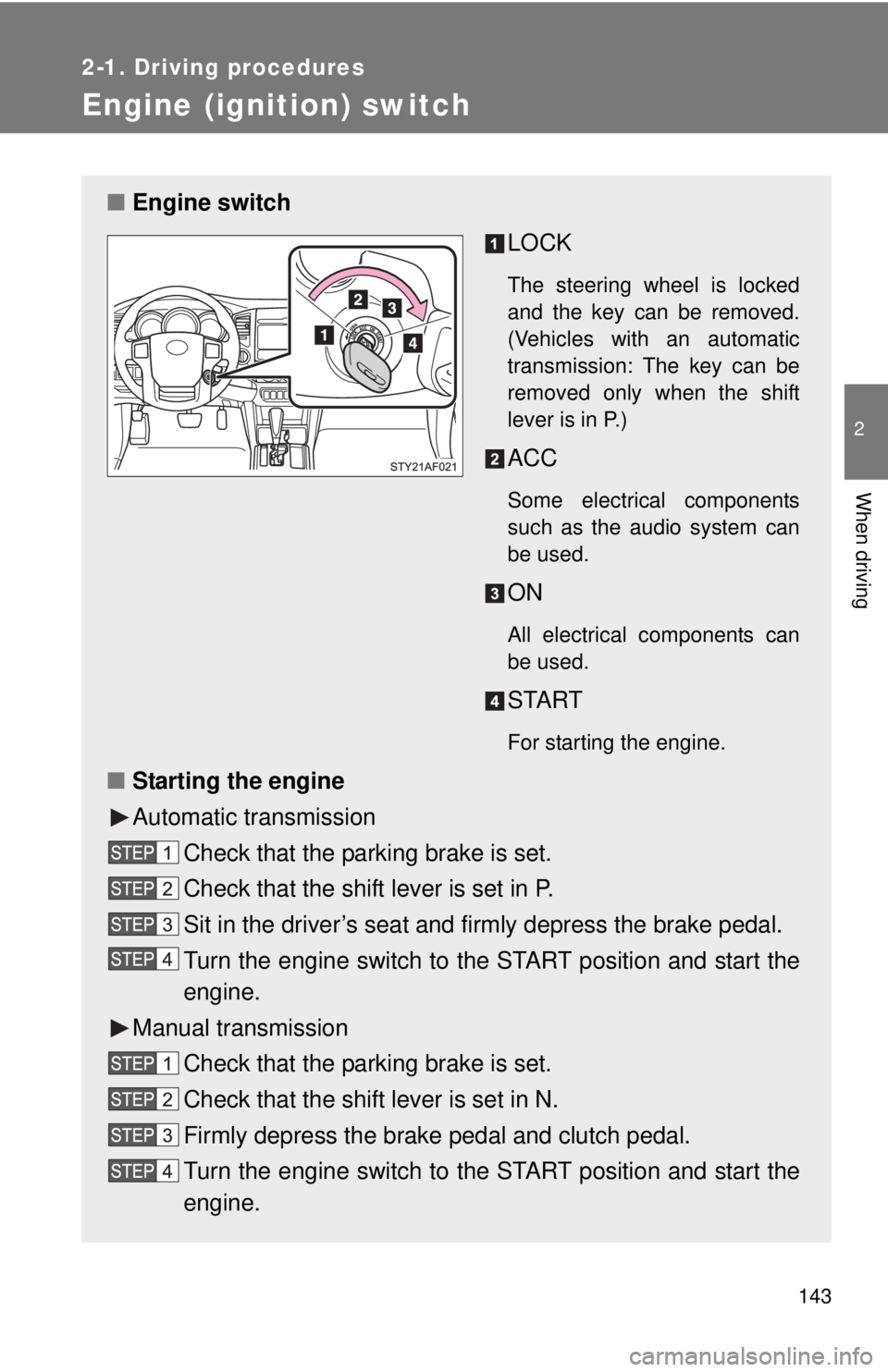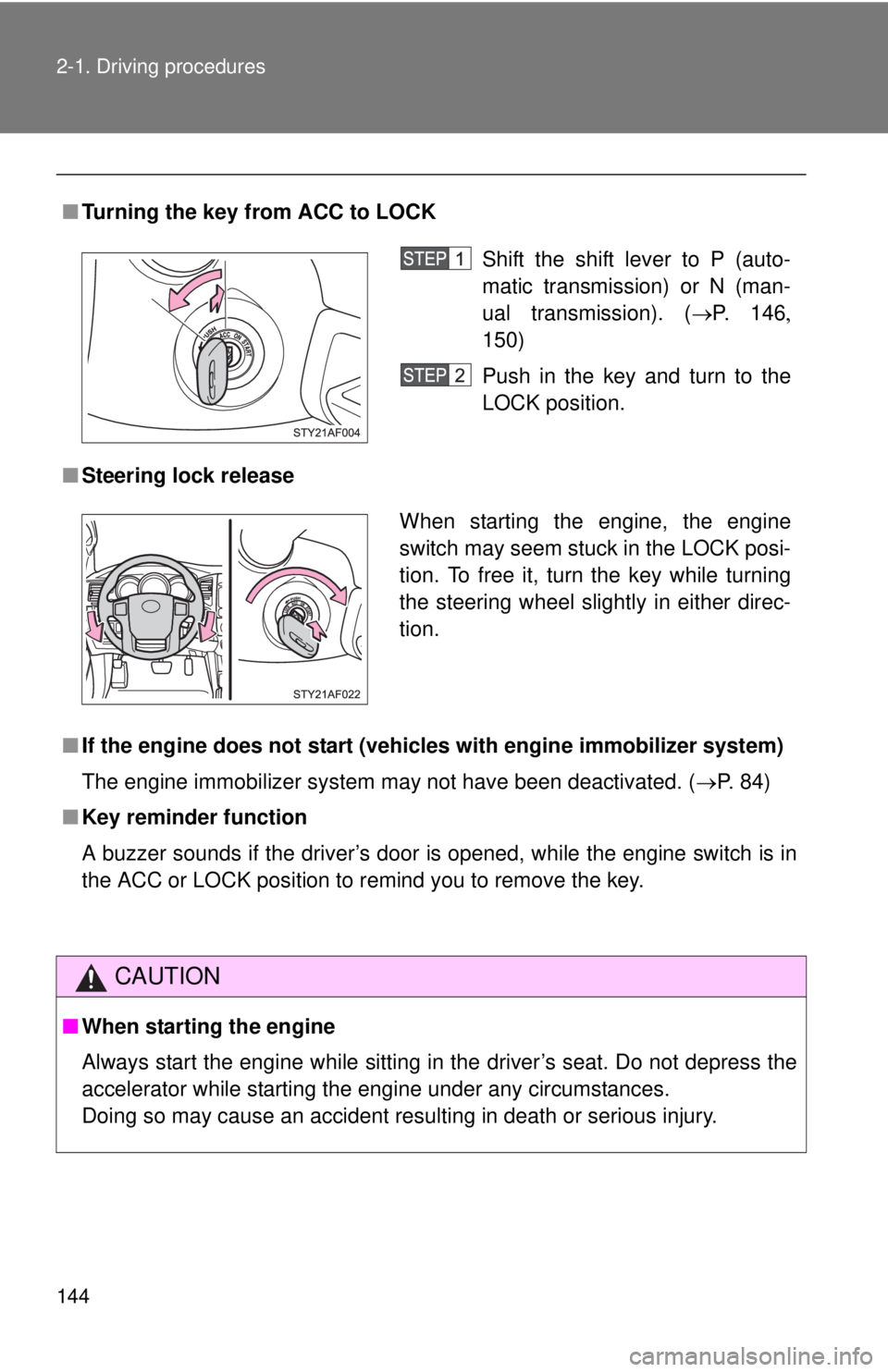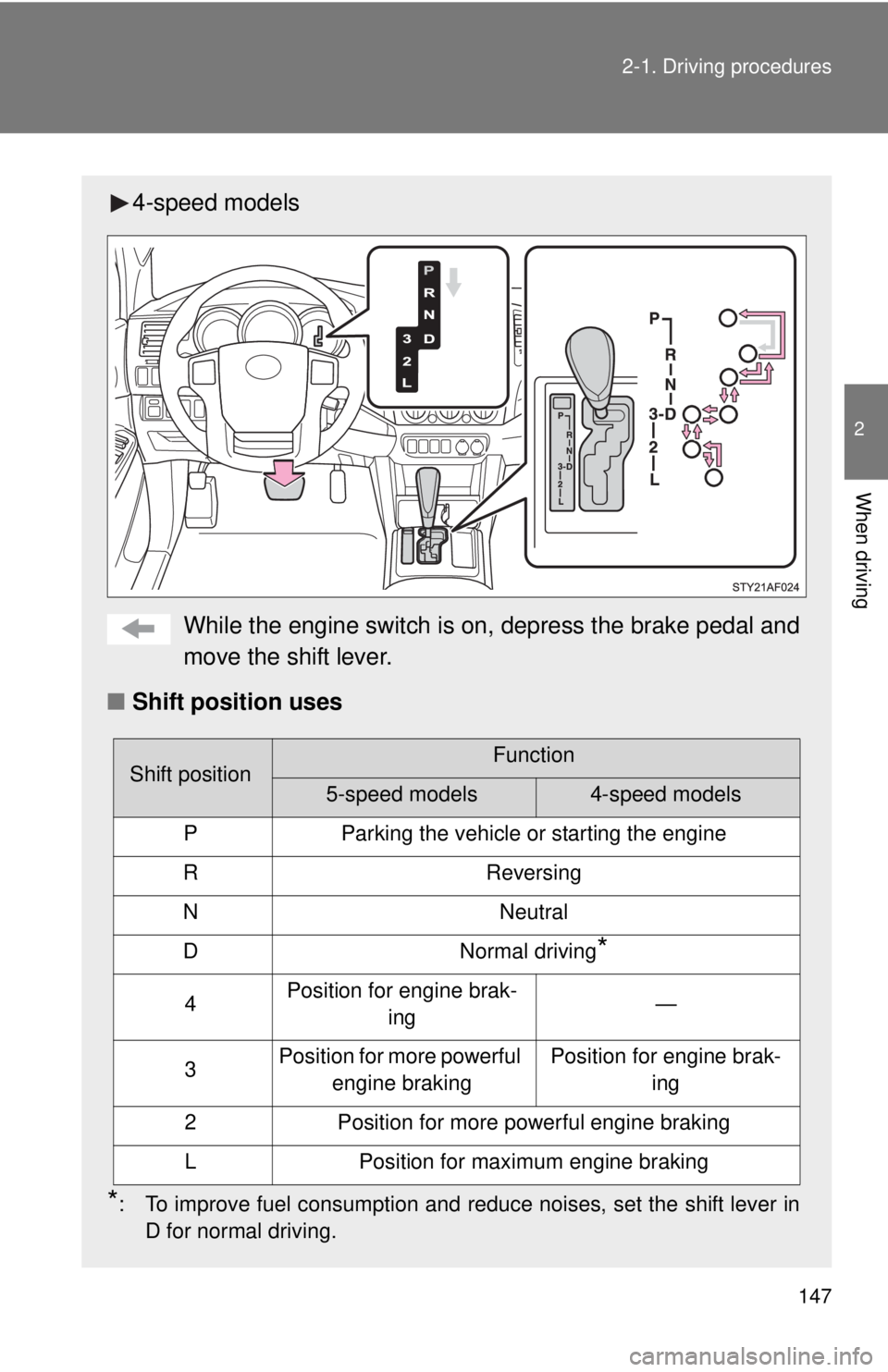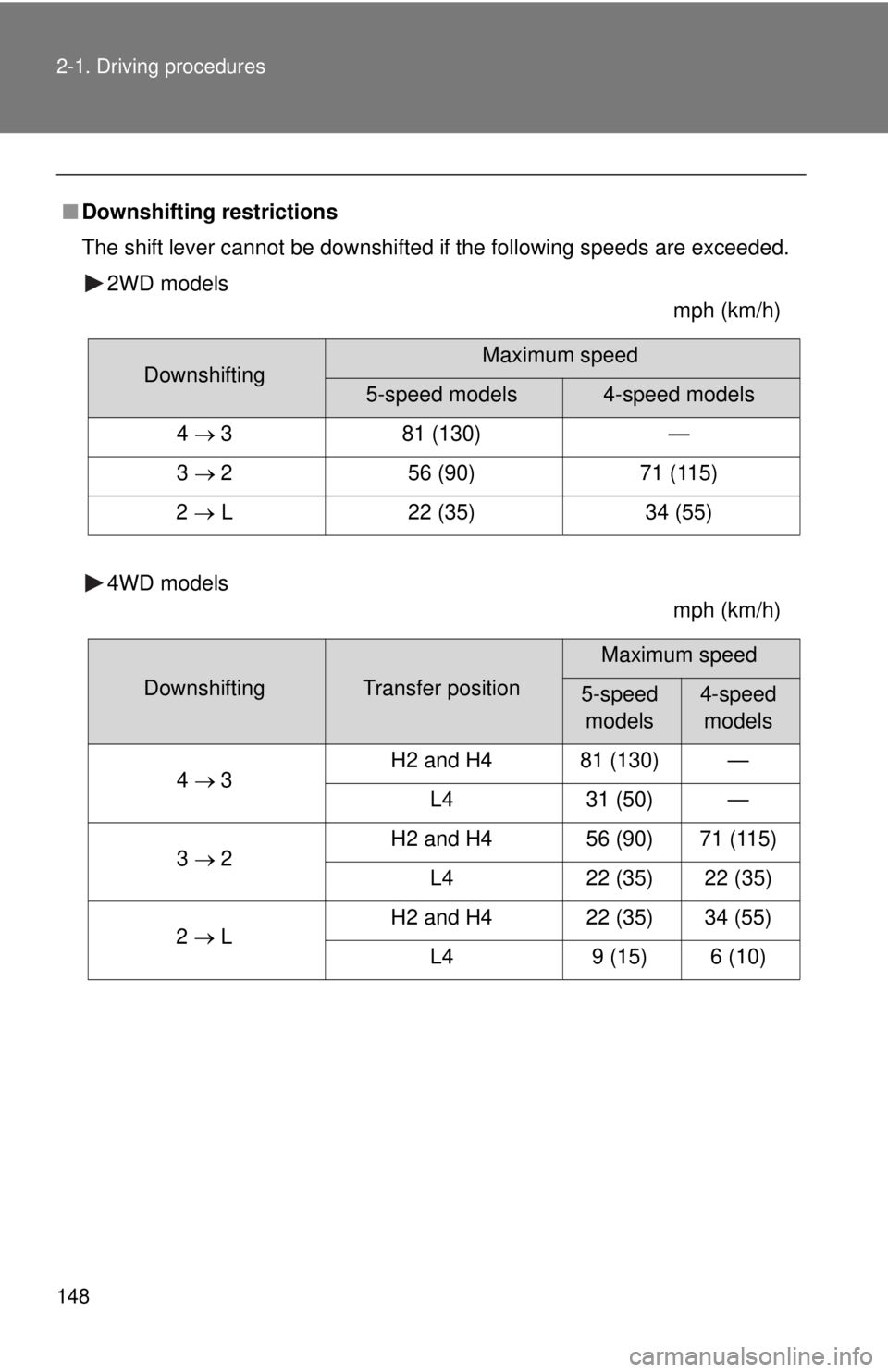TOYOTA TACOMA 2012 Owners Manual (in English)
TACOMA 2012
TOYOTA
TOYOTA
https://www.carmanualsonline.info/img/14/42959/w960_42959-0.png
TOYOTA TACOMA 2012 Owners Manual (in English)
Trending: cooling system, ECO mode, oil filter, climate control, USB, seat adjustment, pairing phone
Page 141 of 628

141
2-1. Driving procedures
2
When driving
NOTICE
■
Avoiding damage to vehicle parts
●Do not turn the steering wheel fully in either direction and hold it there for a
long time.
Doing so may damage the power steering pump.
● When driving over bumps in the road, drive as slowly as possible to avoid
damaging the wheels, underside of the vehicle, etc.
■ If you hear a squealing or scrapin g noise while driving (brake pad wear
limit indicators)
Have the brake pads checked and replaced by your Toyota dealer as soon
as possible.
The rotor damage can result if the pads are not replaced when needed.
It is dangerous to drive the vehicle when the wear limits of the brake pads
and/or that of the brake discs are exceeded.
■ If you get a flat tire while driving
A flat or damaged tire may cause the following situations. Hold the steering
wheel firmly and gradually press the brake pedal to slow down the vehicle.
●It may be difficult to control your vehicle.
● The vehicle will make abnormal sounds.
● The vehicle will behave abnormally.
Replace a flat tire with a new one. ( P. 515)
Page 142 of 628
142 2-1. Driving procedures
NOTICE
■When encountering flooded roads
Do not drive on a road that has flooded after heavy rain etc. Doing so may
cause the following serious damage to the vehicle.
●Engine stalling
● Short in electrical components
● Engine damage caused by water immersion
In the event that you drive on a flooded road and the vehicle is flooded, be
sure to have your Toyota dealer check the following.
● Brake function
● Changes in quantity and quality of oil and fluid used for the engine, trans-
mission, transfer (4WD vehicles), differentials, etc.
● Lubricant condition for the propeller shaft, bearings and suspension joints
(where possible) and the function of all joints, bearings, etc.
Page 143 of 628
143
2-1. Driving procedures
2
When driving
Engine (ignition) switch
■Engine switch
LOCK
The steering wheel is locked
and the key can be removed.
(Vehicles with an automatic
transmission: The key can be
removed only when the shift
lever is in P.)
ACC
Some electrical components
such as the audio system can
be used.
ON
All electrical components can
be used.
START
For starting the engine.
■Starting the engine
Automatic transmission
Check that the parking brake is set.
Check that the shift lever is set in P.
Sit in the driver’s seat and firmly depress the brake pedal.
Turn the engine switch to the START position and start the
engine.
Manual transmission Check that the parking brake is set.
Check that the shift lever is set in N.
Firmly depress the brake pedal and clutch pedal.
Turn the engine switch to the START position and start the
engine.
Page 144 of 628
144 2-1. Driving procedures
■Turning the key from ACC to LOCK
■ Steering lock release
■ If the engine does not start (vehic les with engine immobilizer system)
The engine immobilizer system may not have been deactivated. ( P. 84)
■ Key reminder function
A buzzer sounds if the driver’s door is opened, while the engine switch is in
the ACC or LOCK position to remind you to remove the key.
CAUTION
■When starting the engine
Always start the engine while sitting in the driver’s seat. Do not depress the
accelerator while starting the engine under any circumstances.
Doing so may cause an accident resulting in death or serious injury.
Shift the shift lever to P (auto-
matic transmission) or N (man-
ual transmission). ( P. 146
150)
Push in the key and turn to the
LOCK position.
When starting the engine, the engine
switch may seem stuck in the LOCK posi-
tion. To free it, turn the key while turning
the steering wheel slightly in either direc-
tion.
Page 145 of 628
145
2-1. Driving procedures
2
When driving
CAUTION
■
Caution while driving
Do not turn the engine switch to the LOCK position.
If in an emergency, you must turn the engine off while the vehicle is moving,
turn the engine switch only to the ACC position.
NOTICE
■To prevent battery discharge
Do not leave the engine switch in the ACC or ON position for long periods if
the engine is not running.
■ When starting the engine
●Do not crank for more than 30 seconds at a time. This may overheat the
starter and wiring systems.
● Do not race a cold engine.
● If the engine becomes difficult to start or stalls frequently, have the engine
checked immediately.
Page 146 of 628
146
2-1. Driving procedures
Automatic transmission
: If equipped
Select a shift position appropriate for the driving conditions.
■Shifting the shift lever
5-speed models
While the engine switch is on, depress the brake pedal and
move the shift lever.
Page 147 of 628
147
2-1. Driving procedures
2
When driving
4-speed models
While the engine switch is on, depress the brake pedal and
move the shift lever.
■ Shift position uses
*: To improve fuel consumption and reduce noises, set the shift lever in
D for normal driving.
Shift positionFunction
5-speed models4-speed models
PParking the vehicle or starting the engine
RReversing
NNeutral
DNormal driving*
4Position for engine brak- ing—
3Position for more powerful engine brakingPosition for engine brak- ing
2Position for more powerful engine braking
LPosition for maximum engine braking
Page 148 of 628
148 2-1. Driving procedures
■Downshifting restrictions
The shift lever cannot be downshifted if the following speeds are exceeded.
2WD models mph (km/h)
4WD models mph (km/h)
DownshiftingMaximum speed
5-speed models4-speed models
4 3 81 (130) —
3 2 56 (90) 71 (115)
2 L 22 (35) 34 (55)
DownshiftingTransfer position
Maximum speed
5-speed
models4-speed models
4 3 H2 and H4 81 (130) —
L4 31 (50) —
3 2 H2 and H4 56 (90) 71 (115)
L4 22 (35) 22 (35)
2 L H2 and H4 22 (35) 34 (55)
L4 9 (15) 6 (10)
Page 149 of 628
149
2-1. Driving procedures
2
When driving
■
When driving with the cruise control system (if equipped)
The engine brake will not operate when downshifting from D to 4 (5-speed
models) or 3 (4-speed models). ( P. 174)
■ If the shift lever cannot be shifted from P
P. 533
■ AI-SHIFT
AI-SHIFT automatically selects the optimal gear according to driver perfor-
mance and driving conditions.
AI-SHIFT automatically operates when the shift lever is in the D position.
The engine speed may remain high after releasing the accelerator pedal.
This does not indicate a malfunction.
Page 150 of 628
150
2-1. Driving procedures
Manual transmission
: If equipped
■Shifting the shift lever
6-speed models
Fully depress the clutch pedal before operating the shift lever, and
then release it slowly. 5-speed models
Fully depress the clutch pedal before operating the shift lever, and
then release it slowly.
Trending: fuel consumption, fuse box location, brake rotor, USB, brake pads, towing, horn









